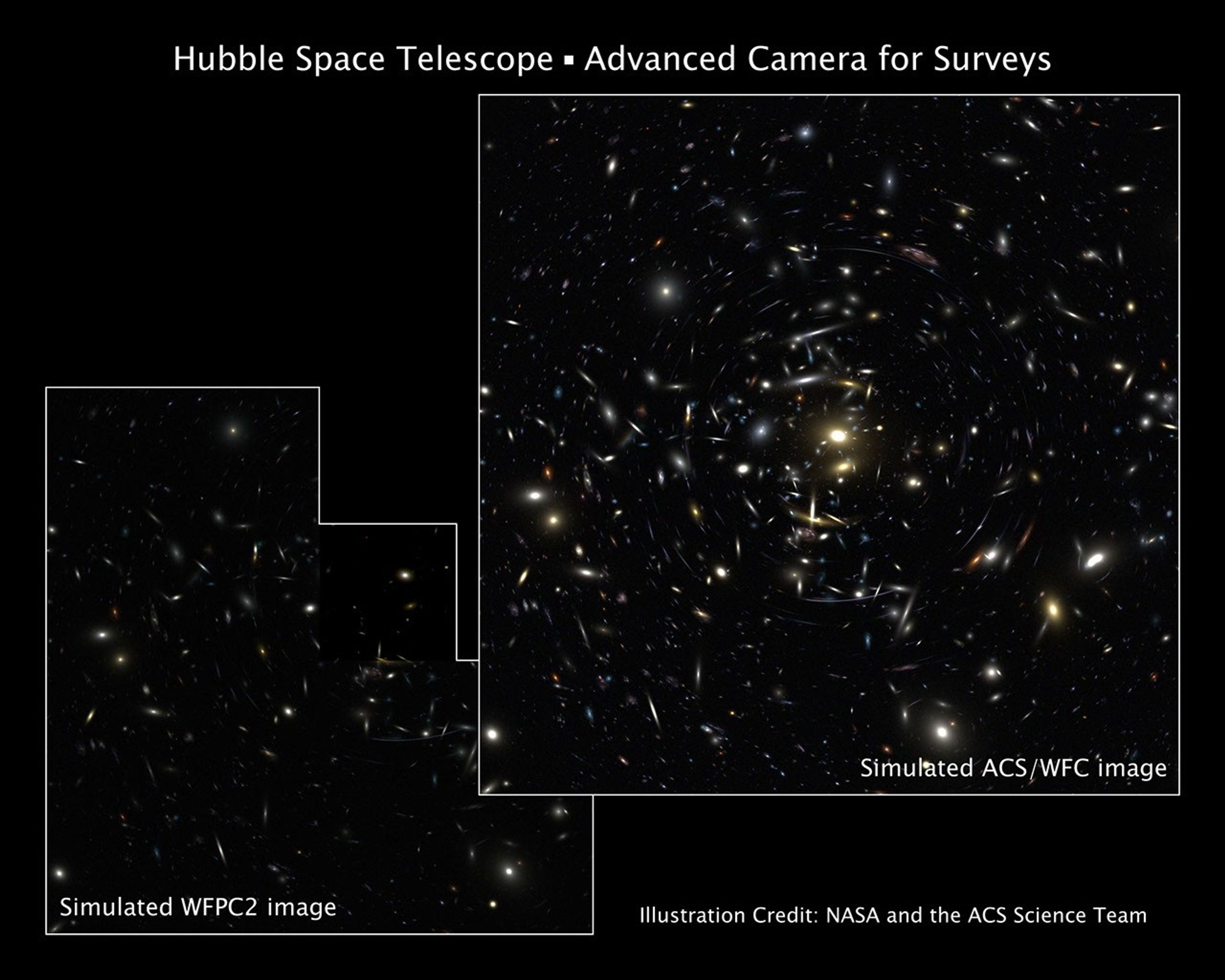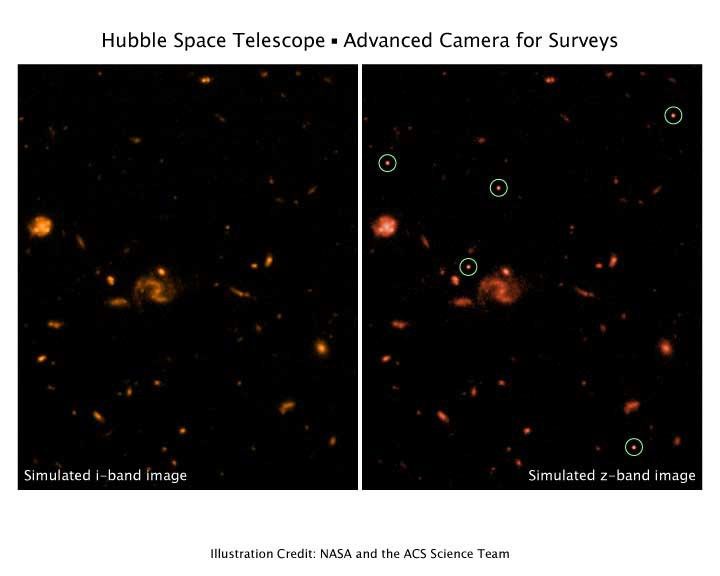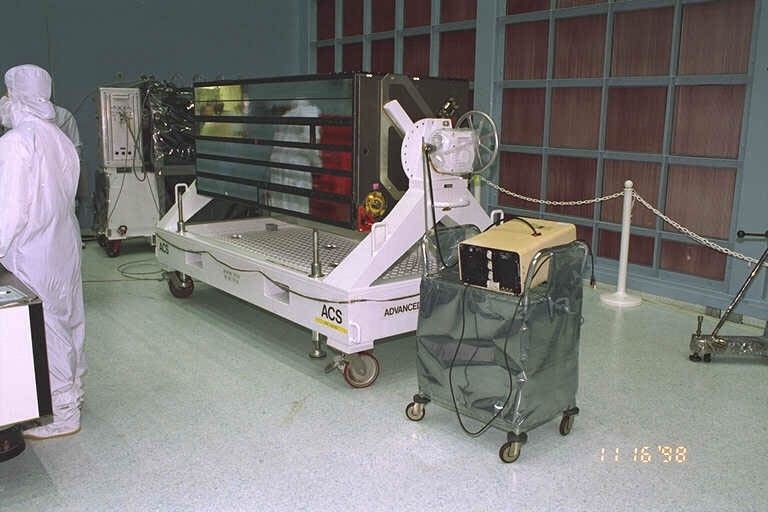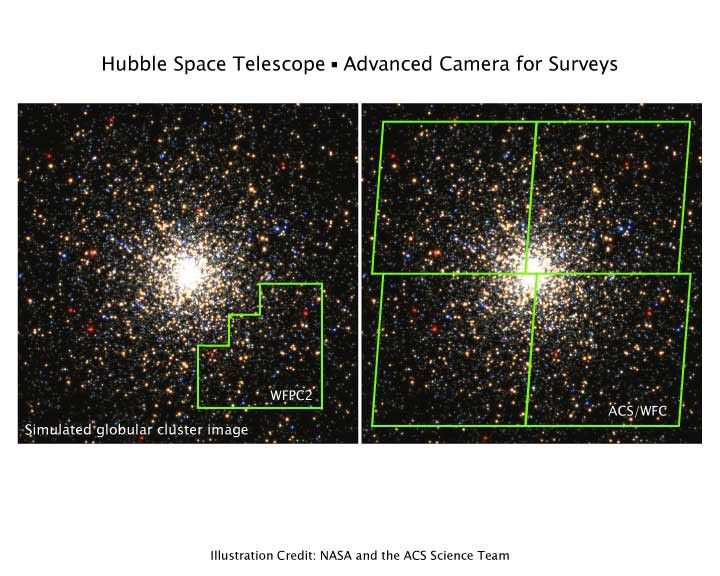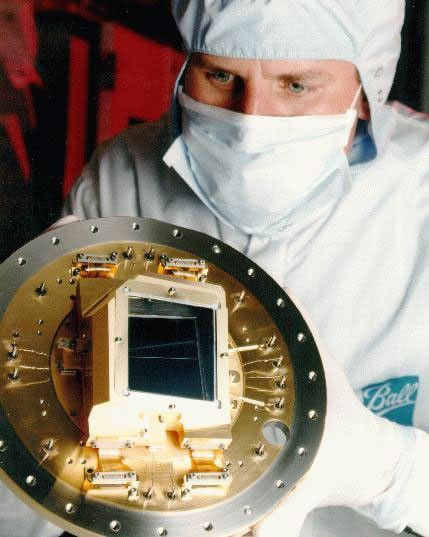NASA's Hubble Space Telescope has been pushing the frontiers of astronomy since its launch in 1990. The orbiting observatory has watched a comet disintegrate as it passed by the Sun and pinpointed a massive star that exploded 10 billion years ago. It has provided a view of a bewildering zoo of young galaxies that existed when the cosmos was a youngster. It has measured the expansion rate of the universe and detected clumps of matter - perhaps the seeds of planets - swirling around nascent stars.
Now its time to expand Hubble's vision even further during Servicing Mission 3B, scheduled to begin Feb. 28 with the launch of the space shuttle Columbia. The mission will give the orbital observatory a series of midlife upgrades that includes the Advanced Camera for Surveys (ACS), a new instrument package that will increase Hubble's already formidable capacity for discoveries tenfold, according to the leader of the team that built it.
"If you had two fireflies six feet apart in Tokyo, Hubble's vision with ACS will be so fine that it will be able to tell from Washington that they were two different fireflies instead of one," says Holland Ford, professor of astronomy in the Krieger School of Arts and Sciences at The Johns Hopkins University and leader of the team that built the ACS over a five-year period.
Ford thinks there's an outside chance that the ACS might even be powerful enough to obtain "direct evidence" - i.e., an image of some type - of planets in other, nearby solar systems. Although planets have been detected around many stars, all of them have been inferred through the gravitational wobbles they impart to their stars, rather than detected through a direct image of the planets themselves.
"I think that there is a chance" we'll be able to directly image a planet, says Ford, clearly tantalized by the prospect. "It's going to be difficult, for sure, but we're going to try it."
The ACS will replace the Faint Object Camera, which is the last of Hubble's original instruments. After catching Hubble with the shuttle's robot arm and securing it in the shuttle's payload bay, spacewalking astronauts will open the servicing doors on Hubble, remove the Faint Object Camera, and install the ACS.
Scientists and engineers who contributed to the ACS came from across the country, but are primarily found at Hopkins, NASA's Goddard Space Flight Center, Ball Aerospace Corp., and the Space Telescope Science Institute. (View the complete list of project staff.)
The ACS weighs 870 pounds and is "about the size of an old-fashioned phone booth," according to Ford. Inside the ACS are three electronic cameras (the wide-field, high-resolution, and solar blind cameras), and a range of filters, polarizers, dispersers and other astronomical tools. ACS can detect radiation ranging from the ultraviolet portion of the spectrum, through visible light, to a portion of the spectrum known as the near infrared.
All the ACS instruments take advantage of new techniques and technology developed since Hubble's inception to deliver increased observing power at greatly reduced costs.
In comparison to the Wide Field Planetary Camera 2, another instrument already in use in Hubble, the ACS will provide two times the observational area, two times the resolution and four times the sensitivity.
"This means a single ACS image will capture more objects in more detail and at a faster rate than before," says Frank Summers, an astrophysicist at the Space Telescope Science Institute.
For example, astronomers like to use Hubble to probe the distant reaches of the universe in a project known as a deep-field survey. If they probe to the same distances as previous surveys, researchers should be able to finish their work approximately ten times faster, reducing their observation time on the telescope from twenty days to just a few days.
ACS also contains an instrument known as a coronagraph that will allow astronomers to block out small bright sources of light in order examine the details of structures around the light sources. Ford noted that this might allow astronomers to search for warps and gaps in the disks of gas and dust surrounding nearby stars that may be early signs of planet formation. The coronagraph will also be very useful to astronomers who study quasars, powerful distant objects in the farthest reaches of the universe that are thought to be highly active black holes in the center of galaxies.
"We're looking forward to taking images of quasars, and seeing the structures that surround the quasars much better with the ACS's higher resolution and higher sensitivity, but especially with the ACS's ability to block the extremely bright emissions coming from the quasar," explains Ford.
Ford and other astronomers have many other ideas for using the ACS, including taking a closer, more detailed look at the weather on planets in our solar system, and no less ambitious a project than verifying the celestial yardstick astronomers have used for several decades to gauge distances around the universe.
"ACS has a set of filters that lets us take pictures in polarized light, which in effect can allow us to see around corners," says Ford. "We plan to use the polarizers to make some geometric measurements of distances using light echoes from supernovae. This will give us very important checks on how we bootstrap distances across the universe."
Noting Hubble's history of astonishing images and breakthrough discoveries, Ford says he's positive that the ACS will help keep Hubble "on the astronomical forefront that the public has come to expect of the Space Telescope."
BACKGROUND INFORMATION: ADVANCED CAMERA FOR SURVEYS EXPANDS HUBBLE'S VIEW OF THE UNIVERSE
NASA's Hubble Space Telescope has been pushing the frontiers of astronomy since its launch in 1990. The orbiting observatory has watched a comet disintegrate as it passed by the Sun and pinpointed a massive star that exploded 10 billion years ago. It has provided a view of a bewildering zoo of young galaxies that existed when the cosmos was a youngster. It has measured the expansion rate of the universe and detected clumps of matter – perhaps the seeds of planets – swirling around nascent stars.
Now its time to expand Hubble's vision even further during Servicing Mission 3B, scheduled to begin Feb. 28 with the launch of the space shuttle Columbia. During the mission, spacewalking astronauts will install the Advanced Camera for Surveys (ACS), a powerful instrument that will allow Hubble to that will significantly increase Hubble's abilities and enable a broad array of new astronomical discoveries. Although Hubble was deployed in 1990, it has remained in the forefront of astronomy because frequent visits by astronauts have kept it humming with cutting-edge science instruments.
The ACS covers twice the area, has twice the sharpness, and is up to five times more sensitive to light than Hubble's workhorse camera, the Wide Field and Planetary Camera 2 (WFPC2). Hubble's deepest visible-light view of the universe, called the Hubble Deep Field, required 10 straight days of observing time with the WFPC2. The ACS will be capable of completing the observation in just a few days.
The ACS is really three cameras in one: a wide-field camera, a high-resolution camera (with a smaller field of view), and a solar-blind camera, which is sensitive to the ultraviolet light. The camera also is equipped with a coronagraph, which blocks out the glare of quasars and stars so that astronomers can examine fainter objects that lie near them. The new camera's vision ranges from ultraviolet to near-infrared light. The wide wavelength range and its three modes of operation make the ACS a very versatile camera. Astronomers will take advantage of this versatility by using the camera for a variety of science observations, from probing far-flung galaxies to hunting for planet-forming disks around nearby stars.
Using the coronagraph, astronomers will hunt for low-mass companions around our nearby stars. A challenging but tantalizing project is to look for small objects orbiting Alpha Centauri A and B. Alpha Centauri A is the nearest Sun-like star to Earth.
The ACS coronagraph is four to six times better than that of Hubble's Space Telescope Imaging Spectrograph. Looking far across the universe, the coronagraph will be used to study the host galaxies of distant quasars, brilliant light beacons which astronomers believe are powered by massive black holes. Astronomers hope to pinpoint the types of galaxies that produce them.
In addition to distant quasars, the ACS will search for very young galaxies that existed less than a billion years after the Big Bang, the explosive birth of the universe. Hubble has provided intriguing clues to how galaxies form and evolve. The ACS's greater sensitivity and higher efficiency will allow astronomers to see objects and details that could never have been seen before. The camera, for example, will be able to spot galaxies that are several times fainter than those detected by the WFPC2, providing more details about how matter combines to form galaxies. The ACS has better vision because it can see deeper into the infrared part of the spectrum. Due to the expansion of space, light from distant galaxies is stretched into the spectrum's infrared region.
One way astronomers will hunt for faint, distant galaxies is by using massive clusters of galaxies as large magnifying lenses. Light from faint, remote galaxies that passes through these clusters is bent and magnified, an effect called gravitational lensing. Using this boost from nature, undetectable galaxies become detectable. Astronomers have assembled a large survey program to hunt for hefty clusters. The survey, spanning 300 orbits, represents about 10 percent of the ACS's yearly observational program. For WFPC2, the same program would eat up a year's worth of observation time. The addition of the more efficient ACS enables astronomers to conduct large surveys for the first time with Hubble.
Astronomers have planned several more sky surveys of more than 100 orbits each. Here is a sampling.
Astronomers will use a suite of space- and ground-based observatories, including the ACS, to probe the universe's earliest galaxies. The ambitious program, called Great Observatories Origins Deep Survey (GOODS), will try to reconstruct the history of galaxy and star formation. They also will study the relationship between supermassive black holes and their host galaxies. These hefty black holes are millions to billions times more massive than the Sun. Astronomers hope to answer several questions, such as, which came first: galaxies or black holes? Or, did they grow together? And, is there a relationship between a galaxy's mass and the mass of its black hole?
This survey will encompass the northern and southern skies. The ACS program alone will require 398 orbits to complete. By comparison, the WFPC2 would need more than 6,000 orbits to complete the program. That is more than two years of observational time.
In scrutinizing distant galaxies in the GOODS survey, astronomers hope to nab eight to 20 supernovae that reside about 8 to 10 billion light-years from Earth. Astronomers will analyze those faraway supernovae to obtain more clues about the mysterious "dark energy," which may be shoving galaxies apart at ever-increasing speeds. Last year, Hubble pinpointed an exploding star, called a supernova, about 10 billion light-years from Earth. The supernova appeared brighter than scientists expected, lending support that at an early epoch the universe slowed down but later began to accelerate. Astronomers must analyze more supernovae to confirm their suspicions that the early cosmos was decelerating and to determine whether dark energy actually exists.
The ACS will scrutinize large clusters of galaxies that lie about 1.3 to 8 billion light-years away. They hope that these clusters will surrender clues why star formation has declined dramatically since about 7.5 billion years ago.
Moving to Andromeda, the nearest large galaxy to Earth, the ACS for the first time will resolve the oldest normal stars in a galaxy other than our Milky Way. The stars, which reside in the galaxy's halo, are the best laboratory specimens for testing theories of galaxy formation and evolution. Astronomers hope to use this information to pinpoint the age of the universe.
Astronomers will use the ACS to analyze the mechanism that triggers gamma-ray bursts, the most powerful explosions in sky, to test the standard model that collapsing, massive stars produce the outbursts.
Turning to our solar system, the ACS will take a census of objects in the Kuiper Belt, a vast region of leftover material from the creation of our solar system. Ground-based observations have found a handful of large objects. Theories suggest, however, that the region is populated mostly with smaller bodies. Astronomers will use the ACS to obtain an accurate sampling of the sizes of Kuiper Belt inhabitants.

























